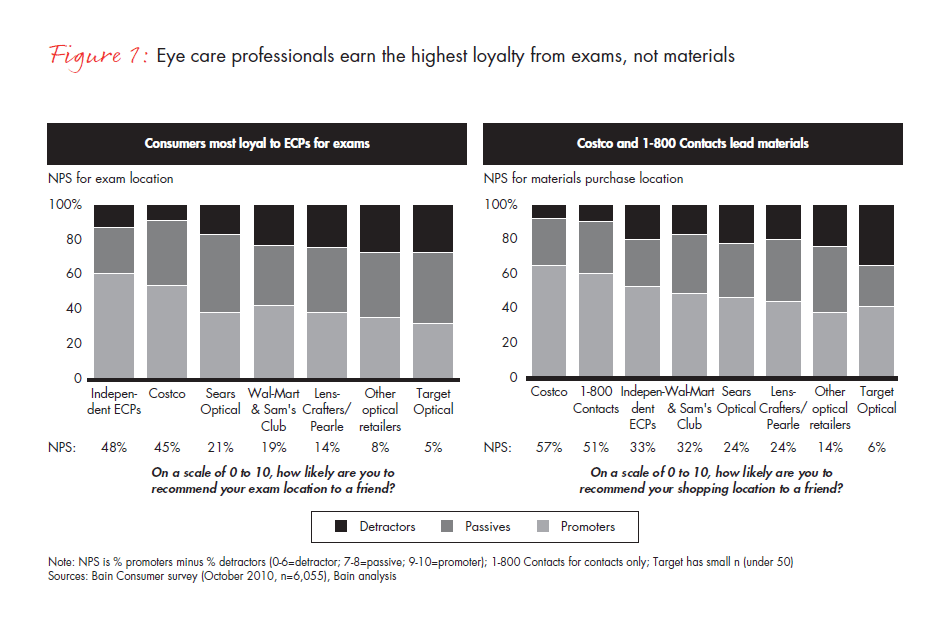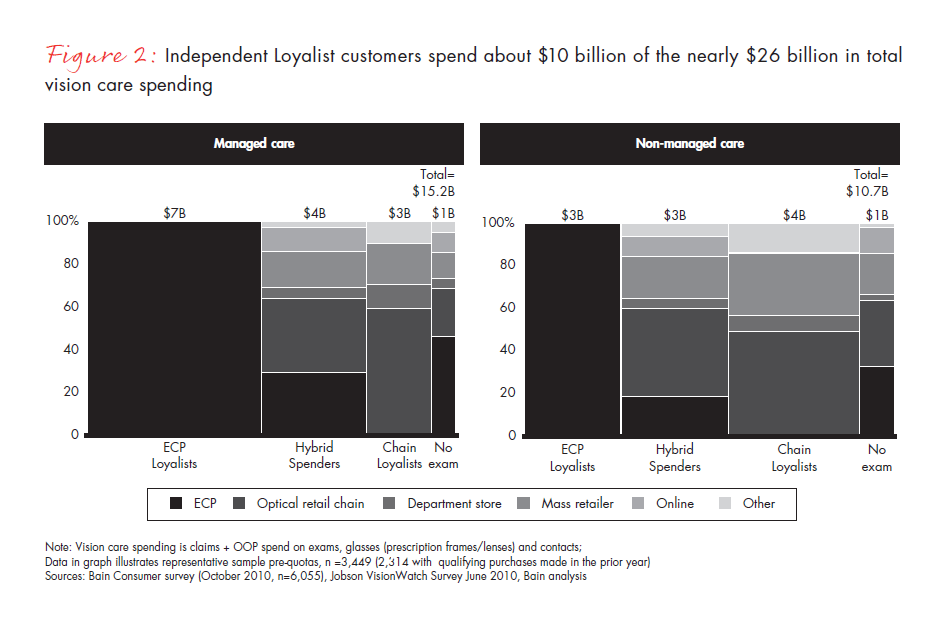Brief
Melanie just got a call from her local optometrist’s office, reminding her it is time for her annual eye exam. She likes Dr. Calderon a lot. He takes time with her and keeps a watch on the effect her diabetes has on her vision. She really needs to get both glasses and contact lenses at this visit, but her vision plan will cover only one. Melanie does some Internet research and discovers that she can buy her contacts online at 1-800 Contacts at a price that is significantly lower than the one Dr. Calderon’s office offers. She decides to get her exam done at Dr. Calderon’s but goes elsewhere for the contacts.
Independent optometry faces a major challenge. Will the industry remain stable, with approximately 50% market share for overall vision care (including optometric services as well as materials like glasses and contact lenses), or will it be forever changed by the same market pressures that have disrupted other industries like books, consumer electronics and independent pharmacies?
Independent optometrists (eye care professionals, or ECPs) and the managed vision care plans with which they contract face pressures similar to other industries:
• The growth of large national chains and mass players that use aggressive and innovative marketing strategies to bring consumers into their channel;
• Increased consumer comfort with buying products online because of rapid improvements in site navigation, product selection and free shipping and returns;
• A desire for greater price transparency on products, hastened by Internet juggernaut Amazon.com and mobile innovations such as RedLaser; and
• A shift from the personalized shopping experience toward more efficient retail environments, as characterized by Wal-Mart and other big-box retailers (see Figure 1).

Meanwhile, the broader vision industry profit pool continues to shift to retail. Vision benefits providers, such as VSP, see vertically integrated player EyeMed/ Luxottica aggressively pricing its plans in order to move consumers to its own retail stores (LensCrafters and Pearle Vision, for example), putting pressure on reimbursement rates for exams—with Luxottica’s underlying desire to increase sell-through of company-owned products as the leading licensor of brands for sunglasses and vision wear. That gradual evolution has focused the employer and consumer on the materials experience, rather than on the exam or the quality of care. Yet eye exams have long been known as one of the best sources for early detection of health risks such as diabetes. For example, 77.7% of adults who had an eye exam at an independent eye care provider’s office within the last six months received a glaucoma test during their exam, compared with 66.6% who went to a chain.1 As some of the larger companies like Wal-Mart hire or contract with their own optometrists and offer exams in their stores, the independent doctor may encounter even more competition for that service.
The fact that revenue for optometrists has not declined substantially—yet—may be lulling doctors into a false sense of security. The optometrists’ share of exams versus materials has hovered around 65% for independent eye doctors, while materials have gradually eroded to about 40%.2 Doctors and their managed-care partners must investigate ways to increase relevance and consumer trust in the materials they sell, facing the reality that theirs is a retail business as well.
The independent optometrist is operating in a highly dynamic retail environment, as online sales growth rapidly outpaces physical retail across categories. For example, nearly 20% of contact lenses sales are now moving online, a fact that “Melanie” has discovered but that “Dr. Calderon” may not fully realize. Eye doctors also need to emphasize and further differentiate the quality of care and personal service they offer—service that is unlikely to be matched by their online competitors.
The growth of chains, both in the US and internationally, has put significant pressure not only on the independent optometrist but also on the vision insurance providers with whom they contract. Retail profits represent as much as two-thirds of the dollars generated in vision care— squeezing the vision benefits providers—as companies like EyeMed/Luxottica lower the price of their benefit plans to entice employers and consumers into their chains. The biggest retailers continue to expand, with the top 50 optical retailers gaining share dramatically from 2003 to 2010.3
Likewise, international markets have experienced shifts to chain retail, with roll-ups of independent optometrists into consistent offerings by retail companies such as Specsavers. In the UK alone, Specsavers gained 3.3% in compounded annual growth rate between 2007 and 2009, while the independents and small chains actually lost 3.9%.4 As a share of the market, independent optometrists in the UK dropped from 45% in 2007 to 41% in 2009, while the independents lost even more dramatically in Australia when Specsavers entered the market in 2008. Stunningly, the independent share is estimated to have dropped from 73% to 55% between 2004 and 2009.
The primary source of revenue and profits for independent optometry is the patient-feeder capability of managed vision care providers like VSP Vision Care, Spectera and others. If these provider networks cannot give the care and shopping experience that consumers demand, then the large-scale employer purchasers of managed vision care plans will shift their purchasing dollars to plans that can.
For employers, the second-most influential factor (after cost) in selecting a managed vision care plan is the retail network the plan provides. Benefits managers not only want but need to provide employees with options for optometry services, given an often diverse employee base; and they often do not even consider contracting with managed vision care plans that do not provide a retail component. Employees want choice, and 80% of managers now report making purchasing decisions that are directed by employee requests. In 2000, only 65% of benefits managers made the same type of purchasing decisions.5
While the role of the employer purchaser remains central to the future of managed vision care service providers, individual consumer preferences increasingly influence both vision benefits plan selection (with growing adoption of voluntary plans) and the ultimate decision of where to go for both exams and materials. In 2010, Bain & Company surveyed 6,000 US consumers, testing preferences for eye care services and identified three consumer segments:6
- Independent Loyalists: Consumers who receive eye exams and purchase glasses or contacts from independent optometrists;
- Hybrid Spenders: Consumers who receive eye exam services from one type of location (typically independent optometrists) and purchase glasses or contacts from another type of location (such as retail chains);
- Chain Loyalists: Consumers who receive eye exams and purchase glasses or contacts from retail chains.
Independent Loyalists spend approximately $10 billion of the $26 billion spent by consumers on vision materials at an independent optometrist (see Figure 2). These highly loyal consumers have been the most stable segment of the consumer market up to now. The Hybrid Spenders, who split their dollars between the independent optometrist and other retailers, are most at risk in terms of loyalty, with $7 billion to $10 billion of spending power residing with this segment. Consumers like Melanie may have started out as Independent Loyalists, but they can quickly migrate to Hybrids or even Chain Loyalists if the independent optometrist doesn’t meet the competition and cost of the more sophisticated retail players.

While the trends may seem daunting for independent optometrists, a number of factors continue to provide a solid base from which to build. Consumers by and large prefer their local independent optometrists for comprehensive eye exams: more than 80% for those in managed vision care programs; more than 60% among hybrid spenders; and more than 40% of chain loyalists.
However, independent optometrists cannot afford to remain complacent. The Bain & Company consumer survey revealed that in the coming 12 months, consumers will be willing to do a lot more purchasing, not only from chain retailers, but also online. Forty-one percent said they would purchase contacts online, 22% would research products online and 21% said they would even purchase glasses online (from upstart companies such as Warby Parker, which offers glasses at $95 with free shipping and free returns).7
Independent optometrists like Dr. Calderon will need to change their behavior in order to survive. They will need to have a stronger materials offering, more transparent pricing, online scheduling for exams, availability of materials to buy or pick up easily in store and faster production of new glasses, while continuing to provide the same personalized service that has won them loyalty up to this point. Category disrupters such as Zappos for footwear or the new upstarts such as Warby Parker for eye glasses are changing the way glasses are purchased and will continue to evolve and deliver higher levels of convenience and value. The independent optometrist must act or be left behind.
Elizabeth Spaulding is a partner in Bain & Company’s San Francisco office and a member of the firm’s Global Retail and Consumer Products practices.
1 Jobson Research, 2010 Adult Consumer Eye Exam Experience Survey
2 Jobson Visionwatch Survey, 2010, accessed October 27, 2011 http://www.thevisioncouncil.org/members/content_13052.cfm?navID=754
3 US Optical Retailer Report, 2005 and 2010
4 Mintel, “Optical Goods and Eyecare,” UK Market Research Report, February 2010, accessed October 27, 2011, http://bit.ly/smwBYN; Euromonitor, “Eyewear in Australia,” May 2010, accessed October 27, 2011, http://www.euromonitor.com/eyewear-in-australia/report
5 Hay Group Vision Prevalence survey, 2009; US Census employment by firm size for 2000; Bain experience
7 Bain Consumer survey, October 2010; Warby Parker website, accessed October 24, 2011, http://store.warbyparker.com/how-we-do-it

